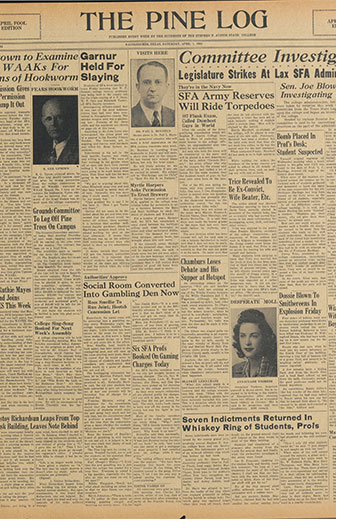1920s
The Stone Fort yearbook was printed using metal plates engraved with a cutting tool called a burin. The section division spreads showed just how intricate the engravings can be with prints showing shading in artwork and smaller details.
1930s
The 1938 Stone Fort staff had 21 editors and one business manager. This was a large staff compared to the 2020s, when between five and 10 people created the book.
1940s

The Pine Log associate editor Irvine Moses took over editing duties for an issue in 1941. "Oldtimers will recall that Moses edited last spring's April Fool edition and a few more on various occasions, so students may rest assured that next week's Log will be a considerable improvement over this and previous rags."
1950s
Stone Fort editors dedicated the 1957 book to the university's oldest students at the time, a canine duo named Tripod and Jess. "These educated two dogs have probably attended more classes, club meetings and other gatherings than any two properly enrolled students on the campus."
1960s
After graduating with her master's degree in the 1970s, Bettye Craddock '70 & '72 took on teaching roles in school districts but finally found her place as the adviser for Kilgore College's former student newspaper, The Flare. Her student and former Pine Log staffer Rachel Stallard '95 & '99 took her role as advisor at Kilgore College and together sent around 30 students from the community college paper to SFA's student publications.
1970s
Overseeing the two publications in the 1970s was Dr. Francine Hoffman, The Pine Log advisor, and Ben Hobbs, Stone Fort yearbook advisor.
The newspaper was produced with basic computers, scissors and waxed machines to paste the copy onto the layout page. A staffer delivered the pasted final product to The Daily Sentinel newspaper office downtown late on Wednesday. The Sentinel press personnel printed the newspapers late at night and delivered them by Friday morning to the Boynton Annex, where they were distributed free throughout the campus and eagerly snatched up by students.
Journalism classes and student publications offices were located in what was then called the Boynton Building Annex, an old military barracks-style building located behind the Boynton Building, which was then the campus library.
1980s
In the late 1970s and throughout the 1980s, The Pine Log doubled its production and began running twice per week.
In 1986, Pat Spence was named student publications advisor and stayed in the position until her retirement in 2014. In that time, Spence helped encourage and enlighten hundreds of students by allowing them to learn from their mistakes.
Student publications began designing pages on Macintosh computers in 1989. After printing their design with a laser printer, they would put their design together by hand.
1990s
In parts of the 1980s and into the 1990s, the student publications offices were in what was once called the University Center Underground — where the university's post office is currently located.
2000s
As technology evolved, so did the production quality of both the newspaper and yearbook. The most notable change was the use of computers to lay out and design both pieces. This practice, barring outages, made the days of laying out the publications by hand virtually extinct.
The decade also brought a change of scenery when student publications moved into their current home after the completion of the Baker Pattillo Student Center renovation in 2007. The offices, as was the case in previous locations, were a place of refuge for staff members. During Hurricane Ike in 2008, Nathan Hague, former Pine Log sports editor, recalled going to the office because it was one of only a few places in town with power.
2010s
In fall 2013, The Pine Log, which printed twice a week for decades, transitioned back to printing once per week on Wednesdays due to dwindling advertisement sales. A year later, Spence announced her retirement.
In 2015, Amy Roquemore, former Pine Log editor-in-chief, replaced Pat Spence following her 28 years in the position. Rachel Clark also joined as student publications coordinator.
2020s
As print came to an end, the student publications department began sending email newsletters in fall 2021 to get stories to its readers and put a more robust focus on social media.
Despite not printing every issue of The Pine Log, student publications produces a physical paper for the Welcome Edition and is planning a special centennial edition to mark the university's 100th year.
Since 2015, SFA student publications has received 262 awards.

 Axe ’Em, Jacks!
Axe ’Em, Jacks!